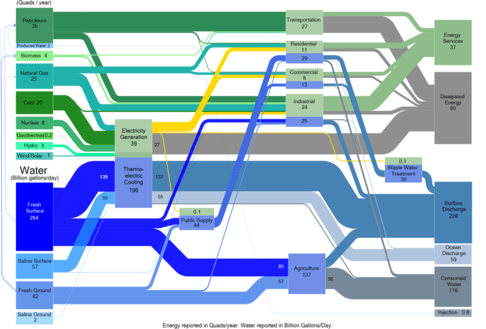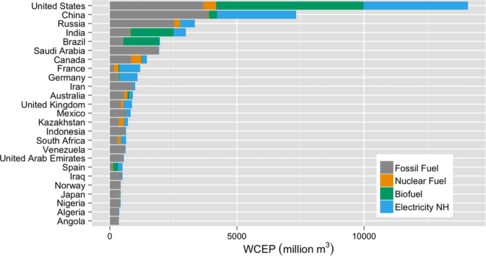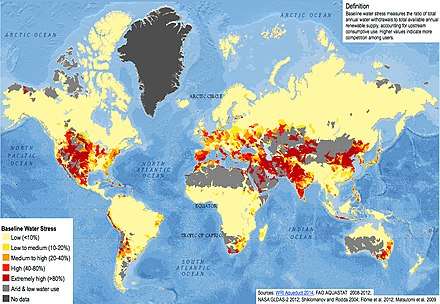Water-energy nexus
There is no formal definition for the water-energy nexus – the concept refers to the relationship between the water used for energy production,[1] including both electricity and sources of fuel such as oil and natural gas, and the energy consumed to extract, purify, deliver, heat/cool, treat and dispose of water (and wastewater) sometimes referred to as the energy intensity (EI). The relationship is not truly a closed loop as the water used for energy production need not be the same water that is processed using that energy, but all forms of energy production require some input of water making the relationship inextricable.

Among the first studies to evaluate the water and energy relationship was a life-cycle analysis conducted by Peter Gleick in 1994 that highlighted the interdependence and initiated the joint study of water and energy.[2] In 2014 the US Department of Energy (DOE) released their report on the water-energy nexus citing the need for joint water-energy policies and better understanding of the nexus and its susceptibility to climate change as a matter of national security.[3] The hybrid Sankey diagram in the DOE's 2014 water-energy nexus report summarizes water and energy flows in the US by sector, demonstrating interdependence as well as singling out thermoelectric power as the single largest user of water, used mainly for cooling.
Water used for energy production

All types of energy generation consume water either to process the raw materials used in the facility, constructing and maintaining the plant, or to just generate the electricity itself. Renewable power sources such as photovoltaic solar and wind power, which require little water to produce energy, require water in processing the raw materials to build. Water can either be used or consumed, and can be categorised as fresh, ground, surface, blue, grey or green among others.[1] Water is considered used if it does not reduce the supply of water to downstream users, i.e. water that is taken and returned to the same source (instream use), such as in thermoelectric plants that use water for cooling and are by far the largest users of water.[3] While used water is returned to the system for downstream uses, it has usually been degraded in some way, mainly due to thermal or chemical pollution, and the natural flow has been altered which does not factor into an assessment if only the quantity of water is considered. Water is consumed when it is removed completely from the system, such as by evaporation or consumption by crops or humans. When assessing water use all these factors must be considered as well as spatiotemporal considerations making precise determination of water use very difficult.
Spang et al. (2014) conducted a study looking at the water consumption for energy production (WCEP) internationally that both showed the variation in energy types produced across countries as well as the vast differences in efficiency of energy production per unit of water use (figure 1).[1] Operations of water distribution systems and power distribution systems under emergency conditions of limited power and water availability is an important consideration for improving the overall resilience of the water – energy nexus. Khatavkar and Mays (2017)[4] present a methodology for control of water distribution and power distribution systems under emergency conditions of drought and limited power availability to ascertain at least minimal supply of cooling water to the power plants. Khatavkar and Mays (2017 b)[5] applied an optimization model for water – energy nexus system for a hypothetical regional level system which showed an improved resilience for several contingency scenarios.
Energy intensity
US (California)
In 2001 operating water systems in the US consumed approximately 3% of the total annual electricity (~75 TWh).[6] The California's State Water Project (SWP) and Central Valley Project (CVP) are together the largest water system in the world with the highest water lift, over 2000 ft. across the Tehachapi mountains, delivering water from the wetter and relatively rural north of the state, to the agriculturally intensive central valley, and finally to the arid and heavily populated south. Consequently, the SWP and CVP are the single largest consumers of electricity in California consuming approximately 5 TWh of electricity each per year.[6] In 2001, 19% of the state's total electricity use (~48 TWh/year) was used in processing water including end uses, with the urban sector accounting for 65% of this.[7] In addition to electricity, 30% of California's natural gas consumption was due to water-related processes, mainly residential water heating, and 88 million gallons of diesel was consumed by groundwater pumps for agriculture.[7] The residential sector alone accounted for 48% of the total combined electricity and natural gas consumed for water-related processes in the state.[6][7]
According to the California Public Utilities Commission (CPUC) Energy Division's Embedded Energy in Water Studies report:
"'Energy Intensity' refers to the average amount of energy needed to transport or treat water or wastewater on a per unit basis."[8]
Energy intensity is sometimes used synonymous with embedded or embodied energy. In 2005, water deliveries to Southern California were assessed to have an average EI of 12.7 MWh/MG, nearly two-thirds of which was due to transportation.[7] Following the findings that a fifth of California's electricity is consumed in water-related processes including end-use,[7] the CPUC responded by authorising a statewide study into the relationship between energy and water that was conducted by the California Institute for Energy and Environment (CIEE), and developed programs to save energy through water conservation.[8][9]
Arab region
According to the World Energy Outlook 2016, in the Middle East, the water sector’s share of total electricity consumption is expected to increase from 9% in 2015 to 16% by 2040, because of a rise in desalination capacity. The Arab region which includes the following countries: Kuwait, Lebanon, Libya, Mauretania, Morocco, Oman, Palestinian Territories, Algeria, Bahrain, Egypt, Iraq, Jordan, Qatar, Sudan, Saudi Arabia, Syria, Tunisia, the United Arab Emirates, and Yemen. Some general characteristics of the Arab region is that it is one of the most water stressed regions of the world, rain fall is mostly rare, or it rains in an unpredictable

pattern.[10] The cumulative area of the Arab region is approximately 10.2% of the world's area, but the region only receives 2.1% of the world's average annual precipitation. Further, the region accommodates 0.3% of the world's annual renewable water resources (ACSAD 1997). Consequently, the region has experienced a declining fresh water supply per capita, roughly a shortage of 42 cubic kilometers of water demand.[11] This shortage is expected to grow three times by 2030, and four times by 2050′.[12] This is crucially alarming given the world's economic stability highly depends on the Arab region.[12]
There are numerous methods to mitigate the growing gap of fresh water supply per capita. One applicable method is desalination which is ubiquitous particularly in the GCC region.[12] All of the world's desalination capacity, approximately 50% is contained in the Arab region, and almost all of that 50% is held in the GCC countries.[12] Countries such as Bahrain provides 79% of its fresh water through desalination, Qatar is around 75%, Kuwait around 70%, Saudi Arabia 15%, and the UAE about 67%. These Persian Gulf countries built enormous desalination plants to fulfill the water supply shortages as these countries have developed economically.[12][13] Agriculture in the GCC region accounts for approximately 2% of its GDP however, it utilizes 80% of water produced.[13] It should also be noted that it requires immense amount of energy mostly from oil to operate these desalination plants. Countries such as Saudi Arabia, Bahrain, and Kuwait will face difficulty to meet the demand for desalination if the current trend continues. The GCC spends 10–25% of its generated electric power to desalinate water.[14][15][16]
Hydroelectricity
Hydroelectricity is a special case of water used for energy production mainly because hydroelectric power generation is regarded as being clean and renewable, and dams (the main source of hydroelectric production) serve multiple purposes besides energy generation, including flood prevention, storage, control and recreation which make justifiable allocation analyses difficult.[1] Furthermore, the impacts of hydroelectric power generation can be hard to quantify both in terms of evaporative consumptive losses and altered quality of water, since damming results in flows that are much colder than for flowing streams. In some cases the moderation of flows can be seen as a rivalry of water use in time may also need to accounted for in impact analysis.
References
- Spang, E. S., Moomaw, W. R., Gallagher, K. S., Kirshen, P. H., and Marks, D. H. (2014). "The water consumption of energy production: an international comparison." Environmental Research Letters, 9(10), 105002.
- Gleick, P. H. (1994). "Water and Energy." Annual Review of Energy and the Environment, 19(1), 267–299.
- Bauer, D., Philbrick, M., and Vallario, B. (2014). "The Water-Energy Nexus: Challenges and Opportunities." U.S. Department of Energy.
- Khatavkar, P., & Mays, L. W. (2017 a) Model for the Real-Time Operation of Water Distribution Systems under Limited Power Availability. In World Environmental and Water Resources Congress 2017 (pp. 171–183).
- Khatavkar, P., & Mays, L. W. (2017). Testing an Optimization/Simulation Model for the Real-Time Operations of Water Distribution Systems under Limited Power Availability. In Congress on Technical Advancement 2017 (pp. 1–9).
- Cohen, R., Nelson, B., and Wolff, G. (2004). "Energy Down The Drain: The Hidden Costs of California's Water Supply." E. Cousins, ed., Natural Resources Defense Council
- Klein, G., Krebs, M., Hall, V., O'Brien, T., and Blevins, B. B. (2005). "California's Water – Energy Relationship." California Energy Commission, Sacramento, California.
- Bennett, B., and Park, L. (2010). "Embedded Energy in Water Studies Study 1: Statewide and Regional Water-Energy Relationship." California Public Utilities Commission Energy Division.
- Bennett, B., and Park, L. (2010). "Embedded Energy in Water Studies Study 2: Water Agency and Function Component Study and Embedded Energy- Water Load Profiles." California Public Utilities Commission Energy Division.
- UNDP (2013) Water governance in the Arab Region: managing scarcity and securing the future. UNDP, New York.
- Devlin J (2014) Is water scarcity dampening growth prospects in the Middle East and North Africa? Brookings Institution, 24 June 2014
- World Bank (2012) Renewable energy desalination: an emerging solution to close the water gap in the Middle East and North Africa. World Bank, Washington, DC.
- Booz and Company (2014) Achieving a sustainable water sector in the GCC: managing supply and demand, building institutions, 8 May 2014.
- Fath H, Sadik A, Mezher T (2013) Present and future trend in the production and energy consumption of desalinated water in GCC countries. Int J Therm Env Eng 5(2):155–162
- Amer, Kamel, et al., editors. The Water, Energy, and Food Security Nexus in the Arab Region. 1st ed., ser. 2367–4008, Springer International Publishing, 2017.
- Badran, Adnan, et al., editors. Water, Energy, & Food Sustainability in the Middle East. 1st ed., ser. 978-3-319-48920-9, Springer International Publishing, 2017.
External links
- California's Water – Energy Relationship
- WaterEnergyNEXUS – Advanced Technologies and Best Practices
- Embedded Energy in Water Studies Study 1: Statewide and Regional Water-Energy Relationship
- Embedded Energy in Water Studies Study 2: Water Agency and Function Component Study and Embedded Energy- Water Load Profiles
- The Water-Energy Nexus: Challenges and Opportunities
- Thirsty Energy